«Day in History» – June 22, 1941 (a joint project of the Republic of Belarus and the Republic of Tatarstan)
June 22, 2024 marks 83 years since that terrible day when the Great Patriotic War burst into the life of our country and each family individually. This is a special countdown of time, a countdown between life, death and immortality.
On Sunday, June 22, 1941, Nazi Germany and its allies unleashed an invasion force unprecedented in history on the USSR.
The first strikes were carried out by German aircraft at dawn. Hundreds of German bombers invaded Soviet airspace. They bombed airfields, troop locations in the western border districts, railway junctions, communication lines and other important facilities, as well as large cities. The Great Patriotic War began – the most difficult of all the wars the country has ever experienced.
The National Archives of the Republic of Belarus contains documents that cover the preparation of Nazi Germany for war, the activities of the Soviet military and political leadership to strengthen the defense capability of the BSSR, the organization of the evacuation of population and material resources to the eastern regions of the USSR, the establishment of the Nazi occupation regime in Belarus, as well as the deployment of partisan and underground movement, the heroism of partisans and underground fighters.
As part of the implementation of the «Day in History» project and the implementation of the Roadmap for the development of cooperation between archival institutions of the Republic of Belarus and the Republic of Tatarstan for 2023-2025, the National Archive of the Republic of Belarus sent archival documents dedicated to the beginning of the Great Patriotic War to the State Archive of the Republic of Tatarstan.
In turn, the State Archives of the Republic of Tatarstan provided copies of documents reflecting the events of the beginning of the Great Patriotic War on the territory of the Tatar Republic.
During the Great Patriotic War, the Tatar Republic received a huge number of civilians. The first stream of evacuated residents of the front-line regions began to arrive in the republic a month after the start of the war. In accordance with the presented list of accommodation of the evacuated population in the TASSR as of August 16, 1941, 162.7 thousand people were accommodated in the republic, of which 31 thousand were children. By December 1, Kazan alone was hosting 142 thousand evacuees.
During the war period, theater groups from other cities were evacuated to the TASSR. Thus, from a letter to the secretary of the Tatar regional committee of the CPSU (b) A.G. Kolybanov from the chairman of the Committee for Arts under the Council of People’s Commissars of the USSR, it follows that the Moscow Theater for Young Spectators was evacuated to Zelenodolsk. Already in March 1942, Tatarstan accommodated more than 250 thousand people both in cities and in rural areas, of which children made up a larger percentage due to pioneer camps, kindergartens, and orphanages. These were mainly children of workers and industrial workers evacuated to Kazan, children of frontline soldiers who had no close relatives, and orphans. An important task among industrial enterprises has become the social protection of large families and expectant mothers, and among children’s and school institutions – full training, inspection and maximum prevention of child homelessness and neglect.
Already on the tenth day of the war, the first trains with wounded began to arrive in Kazan from the front. Thanks to the powerful medical and sanitary base and the presence of highly professional medical personnel, an extensive network of evacuation hospitals was created in the TASSR in a short time. A total of 69 evacuation hospitals with 41,805 beds were deployed. From the report of the People’s Commissar of the TASSR, you can find out that by the beginning of November the republic already had 16,700 beds for wounded soldiers. The highest number was recorded in July 1942 with 31,955 beds. In total, during the war years, more than 300 thousand soldiers and officers underwent treatment in the republic.
Not only the military needed help, but also another vulnerable segment of the population – children. Women activists of the Laishevsky district held a meeting in which it was decided at each village council to support the creation of subsidiary farming, the organization of sewing warm clothes and the conduct of extracurricular activities so that children deprived of a family would feel minimal loneliness and be involved in working life while their parents They defend their homeland with weapons in their hands. The archives of the local press preserved an article by N. Kozlova about the fate of some orphaned children of the war who were evacuated to our area. Work was also carried out to identify the needs of those evacuated to the areas in order to provide them with everything they needed in a timely manner.
During the war years, the largest industrial enterprises in the western regions of the country were evacuated to the Tatar Autonomous Soviet Socialist Republic – more than 70 units in total. Deploying on the basis of already existing factories, they organized the production of military equipment and equipment in the shortest possible time. Along with the priority fulfillment of front-line orders, the industry of Tatarstan was obliged to fully meet the population’s need for manufactured goods.
Some of the evacuated enterprises were also located in cities along the Kama and Volga. The watch factory that arrived from Moscow to Chistopol, as can be seen from the presented report, during the war years was engaged in the production of binoculars, tank watches, fuses for grenades, emergency devices for torpedoes and other precision equipment. In 1942, the industry of Tatarstan faced great challenges, due to the fact that with evacuated enterprises and workers it would be able to significantly increase its production capacity. To the already existing chemical industry enterprises of the city, such as gunpowder plant No.40, SK-4 named after Kirov, film factory, etc., evacuated factories of the oil, rubber and medical industries were added.
In August 1941, the Leningrad Aviation Plant No.387 was evacuated to Kazan and merged with the Kazan Transport Parts Plant No.169 (now the Kazan Helicopter Plant). During the war years, the company produced about 11 thousand Po-2 biplanes for the front. A photograph of the assembly shop of fuselages for Po-2 aircraft at plant No.387 is presented.
In the fall of 1941, the Voronezh Motor Plant No.16 was evacuated to the territory of the Kazan Motor Plant (plant) No.27. The united plant was named «Plant No.16» (now the Kazan Motor-Building Association). The plant was focused on the production of engines and motors, including jet engines, for missile launchers. A photograph of the engine assembly shop at plant No.16 in 1942 has been preserved. In 1943, the first domestic liquid-propellant jet engine, RD-1, was created in the plant’s experimental design bureau, headed by V.P. Glushko.
In October – November 1941, the Moscow Aviation Plant No.22 named after S.P. Gorbunov was evacuated to Kazan to the territory of Plant No.124 named after Sergo Ordzhonikidze. The new enterprise received the official name – «Kazan Aviation Plant No.22 (now KAPO named after Gorbunov). The plant produced one of the best bombers of the Soviet army – Pe-2. In total, more than 10,000 Pe-2 aircraft and 93 Pe-8 aircraft were produced during the war years.
The plant staff repeatedly showed excellent production results during the war. In August-December 1942, the plant’s brigade recovered about 50 destroyed German aircraft, which continued to destroy the enemy under the walls of Stalingrad. 9 members of the brigade were awarded the Government Award «For the Defense of Stalingrad».
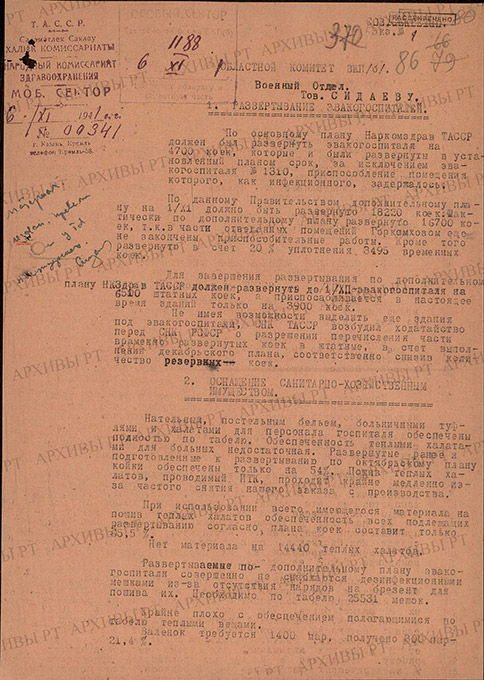 |
| 1. Report of the People’s Commissar of Health of the TASSR to the military department of the Tatar Regional Committee of the All-Union Communist Party of Bolsheviks on the deployment of evacuation hospitals, sheet 1 (November 6, 1941) |
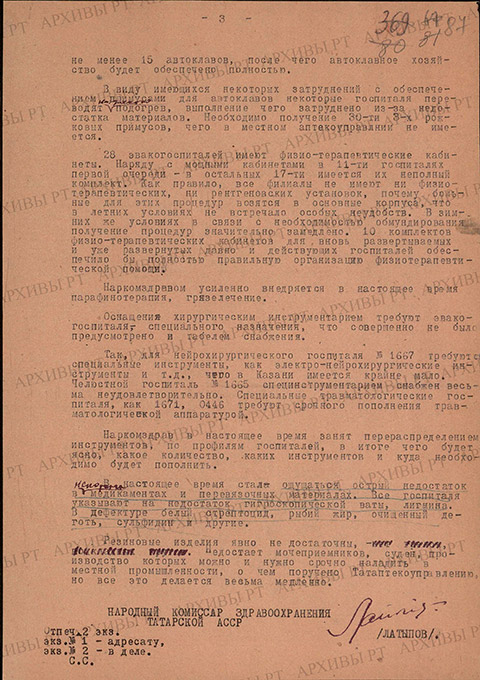 |
| 2. Report of the People’s Commissar of Health of the TASSR to the military department of the Tatar Regional Committee of the All-Union Communist Party of Bolsheviks on the deployment of evacuation hospitals, sheet 2 (November 6, 1941) |
 |
| 3. Information «On the condition of evacuated orphanages and boarding schools in the TASSR» (May 28, 1942) |
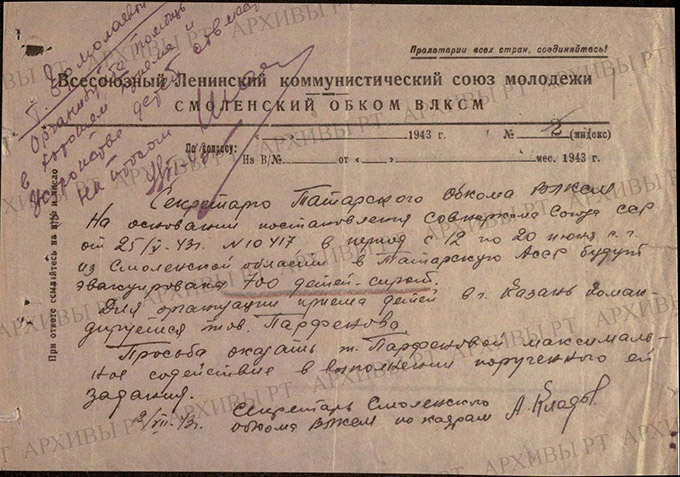 |
| 4. Service memo from the secretary of the Smolensk regional committee of the Komsomol to the secretary of the Tatar regional committee of the Komsomol on the organization of reception of evacuated children (July 3, 1943) |
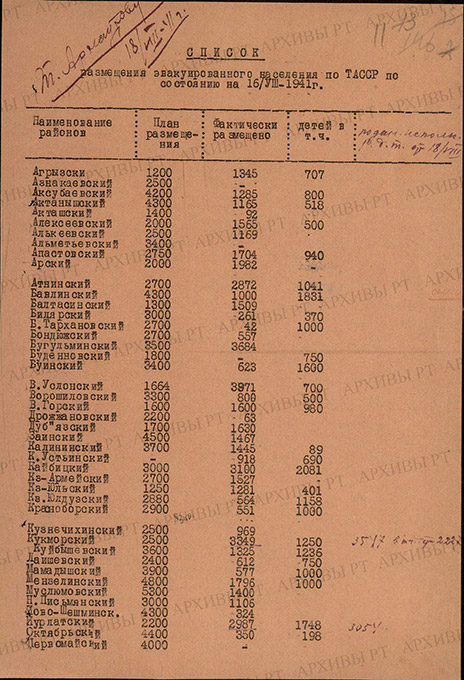 |
| 5. List of placement of the evacuated population in the TASSR, sheet 1 (August 16, 1941) |
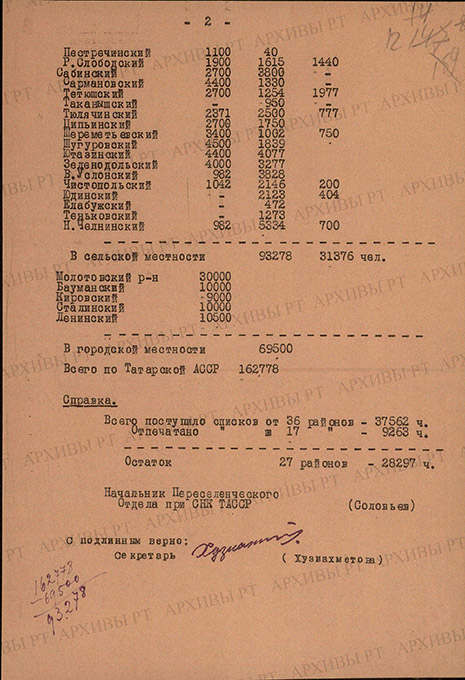 |
| 6. List of placement of the evacuated population in the TASSR, sheet 2 (August 16, 1941) |
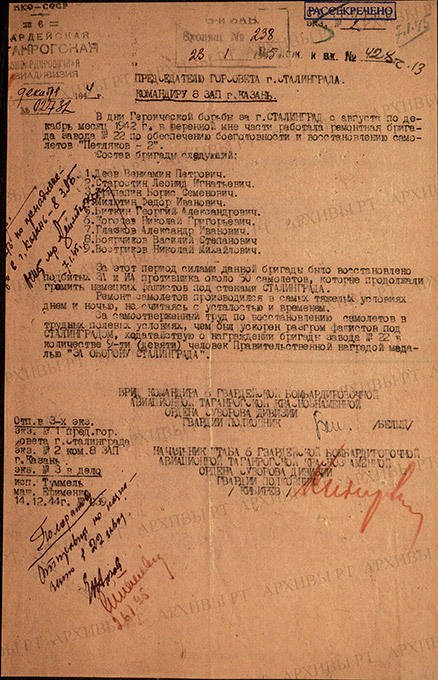 |
| 7. Petition from the command of the 6th Taganrog Bomber Air Division to award the repair crew of plant No.22 with the medal «For the Defense of Stalingrad» (December 4, 1944) |
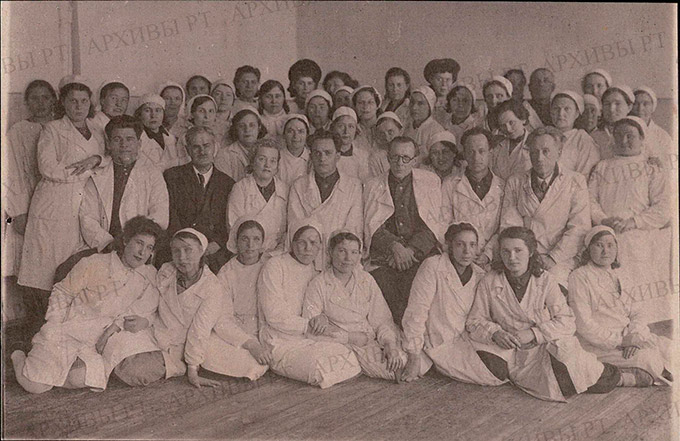 |
| 8. Workers of evacuation hospital No.1665 (1945) |
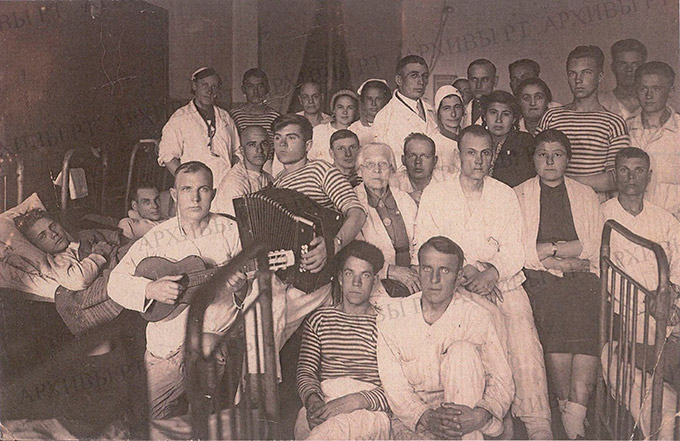 |
| 9. Wounded soldiers of hospital No.1665 (branch building of the Academy of Sciences, Kazan) (1943 – 1944) |
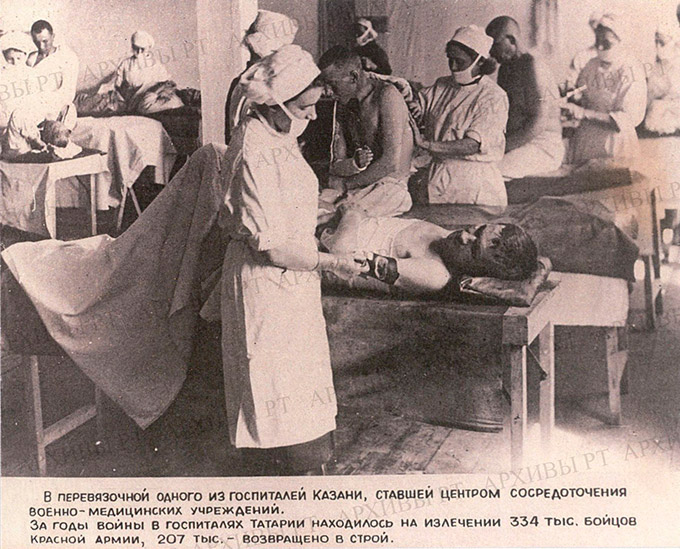 |
| 10. In the dressing room of one of the hospitals in Kazan (1943) |
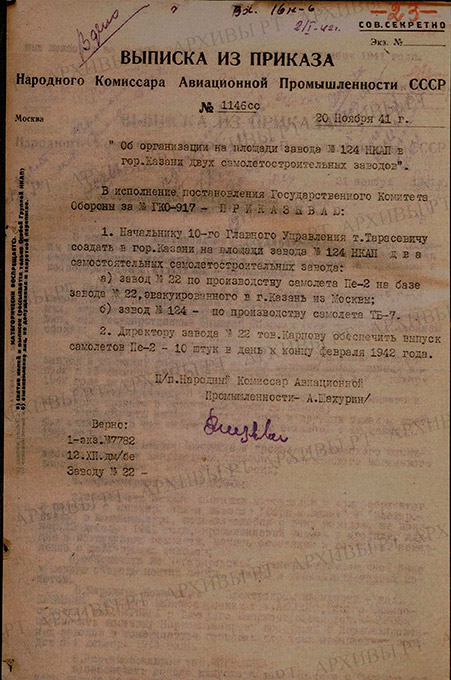 |
| 11. Extract from the order of the People’s Commissariat of Aviation Industry of the USSR «On the organization of two aircraft factories on the site of plant No.124 NKAP in Kazan» for the production of the Pe-2 dive bomber and the TB-7 heavy bomber (November 20, 1941) |
 |
| 12. Assembly shop of fuselages for Po-2 aircraft at plant No.387 (Kazan Helicopter Plant) (1943) |
 |
| 13. Certificate on the work of chemical industry enterprises in Kazan, including those evacuated, during the war period (June 24, 1942) |

